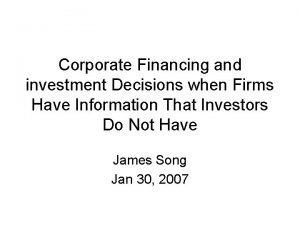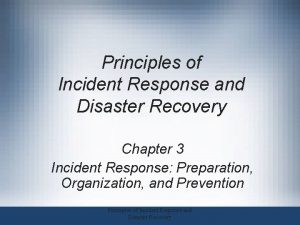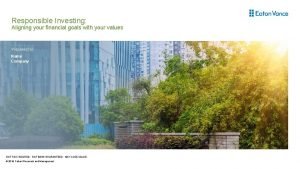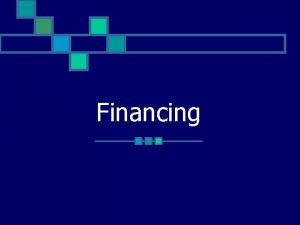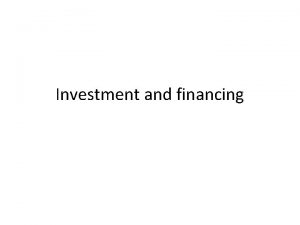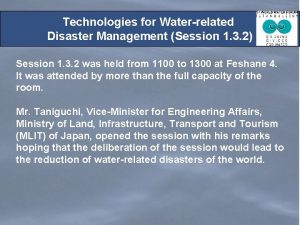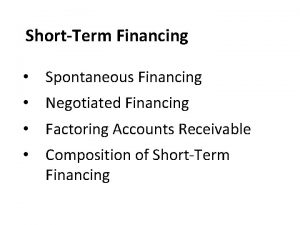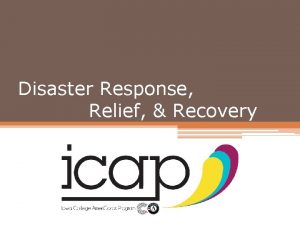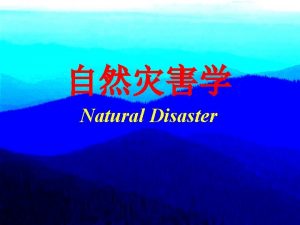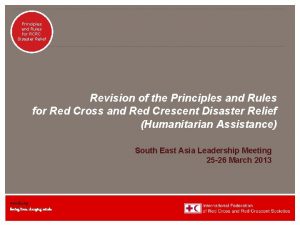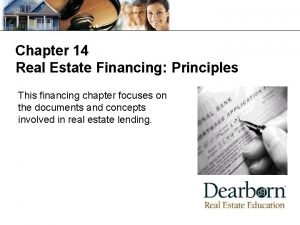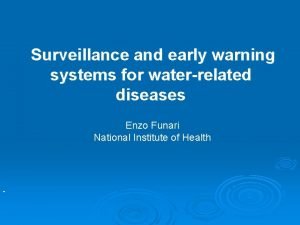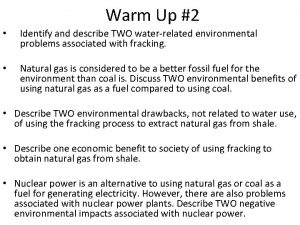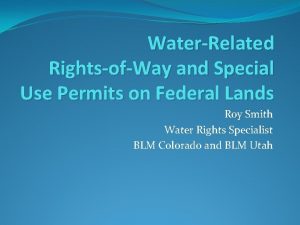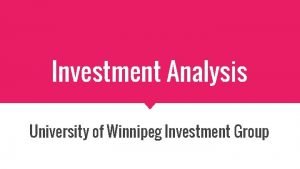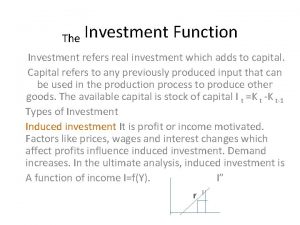Principles on Investment and Financing for Waterrelated Disaster

























- Slides: 25

Principles on Investment and Financing for Water-related Disaster Risk Reduction April 23, 2019 Tomoyuki OKADA High-level Experts and Leaders Panel on Water and Disasters (HELP) Ministry of Land, Infrastructure, Transport and Tourism, Japan

High-level Experts and Leaders Panel on Water and Disasters (HELP) Objectives: Assist the international community, governments and stakeholders in mobilizing political will and resources, and take effective measures to address the issues of water and disasters. Chair: Dr. Han, Seung-soo (Special Envoy of the UN Secretary-General for Disaster Risk Reduction and Water, Former Prime Minister of the Republic of Korea) Members: France, Indonesia, Japan, Myanmar, Netherlands, South Korea, Thailand, US, ADB, EU, AMCOW, JICA, NARBO, OECD, UNESCO, UNISDR, WB, GWP, WWC, and Others. 2

Goal of the Principles • Double the investment and financing for waterrelated disaster risk reduction. • Shift international assistance from disaster response to preparedness. Current Goal Emergency Response/ Rehabilitation 90% 50% 10% Disaster Risk Reduction/ Preparedness 10% 50% 90% 3

Disaster Financing as a Proportion of Total International Aid 1991 - 2010 Source: ODI & GFDRR 4

I. Water-related disaster risk reduction is indispensable for socio-economic development. 1. Water-related disasters can be prevented or mitigated by disaster prevention infrastructure, including levees, reservoirs, resilient infrastructure, or green infrastructure. 2. Countermeasures implemented in advance against waterrelated disasters are not a cost, but an investment for the future. 3. Water-related disaster risk reduction is a key component of Integrated Water Resources Management (IWRM), providing multi-faceted benefits, such as efficient water use and enhanced biodiversity. 5

Effect of Preventive Measures Tokai Storm Flood (September, 2000) 670 Billion yen Effect of prevention project: 550 billion yen Effectiveness 7. 7 (=550/71. 6) 120 Billio n yen Example of Countermeasure: Levee Reinforcement Actual damage to general assets Simulated damage from same heavy rain after the completion of prevention measures 71. 6 billion yen Cost of prevention measures after disaster 6

II. Pre-disaster prevention measures should be prioritized. 4. Frequent water-related disasters should be forestalled by preventive structural measures at lower cost than recovery. 5. Devastating damages to society and economy should be prevented, while prioritizing the protection of human lives. 6. “Build Back Better” approach should be incorporated into recovery and reconstruction. 7. Various sectors should support “mainstreaming disaster risk reduction. ” 8. Climate change is predicted to intensify disaster damages. Investment should be enhanced for adaptation measures. 9. Investment for the maintenance and management of infrastructure should be secured to cope with its aging issues. 7

Management of Aging Infrastructure Ratio of River Facilities that Passed 40 Years in Japan Year 2011 40% 2021 60% 2031 80% As the number of aging infrastructure is rapidly increasing, disaster risk is growing. Problems of Aging Infrastructure Aging Gate Aging Coastal Levee 8

III. Governments should improve their fiscal systems and secure sufficient budget. 10. Governments must prepare the legal, budgetary and administrative systems for disaster risk reduction. The central government should assist local governments whose capacities are overwhelmed by disasters. 11. Responsibilities of all stakeholders, including residents, local and central governments, should be defined, empowering the local governments and communities. 12. Local and central governments should secure and record budget for pre-disaster risk reduction. 13. Emergency reserve fund can be swiftly disbursed after disasters. 9

Effect of Flood Management Investment Fatalities by Floods , GDP, and Flood Management Budget in Japan Note: Number of fatalities exclude tsunami disasters. 10

IV. Various funding sources should be mobilized. 14. Mobilization of private funds can support increasing demand for resilient infrastructure. Cooperation with other sectors, such as water resources management and urban planning, helps diversify funding. 15. Incentives for awareness raising and self-prevention measures by the private sector should be explored with subsidies and tax exemptions. 16. Flood insurance is effective for the speedy recovery of daily life. However, it does not physically reduce flood risks. 11

High-Standard Levee Development with the Private Sector High-standard Levee Urban Development on the Levee Arakawa River and Shinden district in Adachi City Before project After project 12

V. International community should expand financing for disaster risk reduction. 17. International cooperation in disaster prevention should be strengthened under the international frameworks. Even a single disaster in one country creates ripple effects to the world through supply chains, migration, etc. 18. Surplus fund in emergency assistance should be utilized for further disaster risk reduction. 13

VI. Science and technology should support decision making on better investment. 19. Data and knowledge on disaster losses and impacts should be improved to evaluate the effectiveness of investment. 20. Cooperation and alliances among science communities should be enhanced. 14

Roadmap for Developing the Principles ・・ 2018 2028 Consultation & Launch Monitoring 2017 Drafting & Discussion 3 rd UN Session Jul. 2017 WWF 8 Mar. 2018 WWW Aug. 2017 HELP 10 Sep. 2017 APWS 3 Dec. 2017 HELP 11 May 2018 Dushanbe HLC Jun. 2018 AMCDRR Jul. 2018 Water Decade (2018– 2028) HLPF Jul. 2018 HELP 12 Nov. 2018 WWW 4 th UN Session Aug. 2018 Jun. 2019 GWP 2018 -19 15

Consultations on the Principles Objectives • Collect comments on the proposed Principles from various stakeholders • Formulate the Implementation Plan of the Principles Organizers • HELP • Global Water Partnership (GWP) Participants Governments, International organizations, Academia, NGOs, Private sectors, etc. 16

Schedule of Consultations Year 2018 October 9 October 12 October 31 November 27 Year 2019 March 1 March 22 April 18 April 23 June 24 GWP Central/Eastern Europe Meeting in Bucharest GWP South Asia Meeting in Colombo GWP Southern Africa Meeting in Livingstone 12 th HELP Meeting in Tokyo I&W/OECD Meeting in Paris GWP Southeast Asia Meeting in Hanoi 2 nd I&W/OECD Meeting in the Hague GWP South America Meeting in Montevideo 4 th UN Special Session on Water and Disasters in NY Launch of the Principles & its Implementation Plan 17

Brain Storming Session You are asked to: 1. Reading and writing • Read the Principle on Financing and Investing for DRR • Think and write your comments on the Principle 2. Group Discussion • Choose a moderator and rapporteur of the Group • Share your idea in group discussion • Discuss and decide the most important suggestion on the principle (changes, additions, new ideas…) of the group. 3. Plenary discussion • Rapporteurs to report the most important suggestion in the plenary discussion. • Give your comments, if any, as additional contribution

Thank you. High-level Experts and Leaders Panel on Water and Disasters (HELP) http: //www. wateranddisaster. org/

Discussion • • Fill in the questionnaire Divided into 3 groups Select a chair/rapporteur in the group Table discussion 1 on the Principles Modification, Application Plenary discussion to share findings Table discussion 2 on disaster recovery Effectiveness, Communication, Responsibility Plenary discussion to share findings Summary/Closing 20

HELP-GWP Consultation Meeting on the Principles in Central and Eastern Europe Date: 9 th October, 2018 Venue: National Meteorological Administration, Bucharest, Romania Participants: 22 persons from 10 countries (Ukraine, Moldova, Georgia, Armenia, Romania etc. ) 21

Key Points from Consultation Meetings • • • • Urban/land use planning without causing negative impact Natural resources management National risk management plan Target disasters (local, drought, man-made) DRR cost is a part of project lifecycle cost Access to relief aid Guideline of recovery Prevent water-borne diseases Marginalized people (women, youth, human trafficking) Political will / decision makers Climate change adaptation From disaster management to risk management National assistance in addition to international one Insurance changes people’s behavior Insurance supplement government budget 22

Key Points from Consultation Meetings • • • • Co-financing between public and private sectors Incentives to private sector Water pricing, showing benefit and cost of water use Fee-based management Beneficially trust fund, international DRR fund Social and environmental responsibilities of private sector Effective evacuation by early warning Transboundary project Communication facility in communities Soft investment in education and capacity building Promote innovation Interpretation of scientific information Indigenous knowledge Media disseminates disaster experiences Open data on risk 23

Key Messages of the Principles 1. Water-related disaster risk reduction is indispensable for socio-economic development. 2. Pre-disaster prevention measures should be prioritized. 3. Governments should improve their fiscal systems and secure sufficient budget. 4. Various funding sources should be mobilized. 5. International community should expand financing for disaster risk reduction. 6. Science and technology should support decision making on better investment. 24

Consultations on the Principles Consultation Meeting • Organized back-to-back with major international conferences and GWP regional meetings • Duration of up to a half day • Introductory presentation followed by group discussions 1 st Session on the contents of Principles 2 nd Session on the Implementation Plan of the Principles 25
 Pecking order theory
Pecking order theory Slidetodoc.com
Slidetodoc.com Fixed investment and inventory investment
Fixed investment and inventory investment Principles of incident response and disaster recovery
Principles of incident response and disaster recovery Principles of incident response and disaster recovery
Principles of incident response and disaster recovery What is disaster
What is disaster Deforestration
Deforestration Product safety examples
Product safety examples Kontinuitetshantering
Kontinuitetshantering Novell typiska drag
Novell typiska drag Tack för att ni lyssnade bild
Tack för att ni lyssnade bild Returpilarna
Returpilarna Varför kallas perioden 1918-1939 för mellankrigstiden
Varför kallas perioden 1918-1939 för mellankrigstiden En lathund för arbete med kontinuitetshantering
En lathund för arbete med kontinuitetshantering Underlag för särskild löneskatt på pensionskostnader
Underlag för särskild löneskatt på pensionskostnader Personlig tidbok fylla i
Personlig tidbok fylla i A gastrica
A gastrica Vad är densitet
Vad är densitet Datorkunskap för nybörjare
Datorkunskap för nybörjare Tack för att ni lyssnade bild
Tack för att ni lyssnade bild Debattartikel mall
Debattartikel mall Autokratiskt ledarskap
Autokratiskt ledarskap Nyckelkompetenser för livslångt lärande
Nyckelkompetenser för livslångt lärande Påbyggnader för flakfordon
Påbyggnader för flakfordon Vätsketryck formel
Vätsketryck formel Svenskt ramverk för digital samverkan
Svenskt ramverk för digital samverkan
